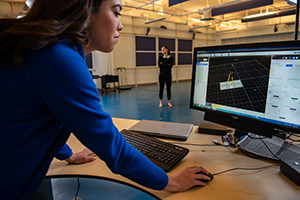Nayeli Munoz research focuses on Age-related changes in multisegment foot and lower limb mechanics
Author: Linda OBrien
Posted on Jan 13, 2020
Category: Research

Studying the mechanics of gait in healthy and clinical populations can greatly improve our knowledge of movement. During gait, the foot and ankle functions to attenuate shock at impact, provide stability and support of the lower limb, and aid in forward propulsion of the body. Given such important factors of the ankle/foot complex in gait, it is plausible that changes in foot function may result in impaired movement patterns. Furthermore, the mechanics of the foot and ankle during gait are poorly understood. Further research examining mechanical models of the foot and age-related changes in foot mechanics are warranted. For a better understanding for the mechanics of foot, researchers have developed different mechanical models called multi-segment foot models, which divide the foot in different segments in order to study the movement between each one of them (e.g. forefoot vs. midfoot).
Previous studies have reported that physical impairment increases with age and is related to changes in mobility and gait. There are different age-related changes that may influence the walking pattern, including walking speed and foot structure. One of the major gait-related consequences of aging is compensatory adaptations that older adults exhibit typically in gait patterns, including shorter steps and slower walking speed. The emerge of this compensatory strategy might be for increasing stability, avoiding falls, or reducing the energetic cost of mobility. Also, foot structure undergoes age-dependent changes and foot development and maturation is accompanied by variations in its shape and function. However, the interrelationship between age-related changes in foot mechanics and physical function with ageing are not clear.
Thus, to address the limitations of current work and increase our understanding of age-related changes in multisegment foot motion, the purpose of my study is to investigate differences in multi-segment foot and lower limb mechanics between young and older adults during walking, separating the speed effects from age-related changes in motion. The relationship between age-related changes in foot mechanics and foot structure will also be explored.
Benefit:
This study will contribute to enhance what we know so far about how the age-related changes in foot structure and mobility, as well as walking speed affect the walking pattern of older people. In addition, it will contribute to increase the knowledge of the mechanics of the foot and ankle during gait. Also, the data provided can be used as a reference of healthy gait parameters to compare it to clinical gait parameters (e.g., patients with planus and cavus feet, diabetic foot, or after stroke). Findings from this study may also contribute to an accurate engineering design for wearable device technology, e.g., footwear, prostheses, orthoses and exoskeletons.
Background: My name is Nayeli Marcial, I am 24 years old and I am from Chihuahua, Mexico. I graduated as a Biomedical Engineer at the university Tecnológico de Monterrey campus Chihuahua in 2018. Since the beginning of my undergrad, I always had a great interest in biomechanics. In my last year of undergrad, I had the opportunity to do a summer research internship at UNB through the Mitacs internship program. I was working during the summer under the supervision of Dr. Victoria Chester and Dr. Usha Kuruganti, which gave me the opportunity to come back and pursue my master’s degree.
I found the lab was one of its kind with all the advanced facilities and all the cutting-edge technology they have, besides the professors, who are very inspiring and have a lot of experience in biomechanics. These are the reasons why I decided to join a master’s program at UNB and work towards my research interest.
Seeing all the technology that the Human Performance Lab has, their members and the projects that have been done made me discovered my love for research and strengthen my passion for biomechanics. The Human Performance Lab has given me the opportunity to learn about new equipment like the motion capture system, force plates, 3d body scanner, 3d printer, pressure mat, accelerometers, etc., and work on different projects from walking patterns in autism children to measure physiological and biomechanical performance of varsity athletes.
I am grateful for this great opportunity and I’m looking forward to keep working as part of the human performance lab team!
